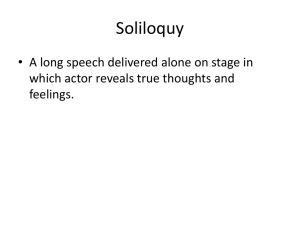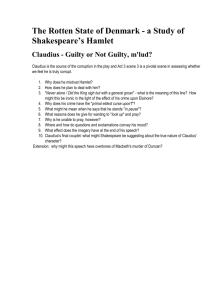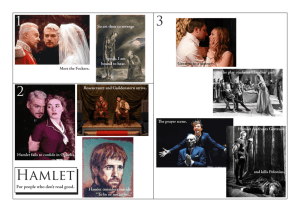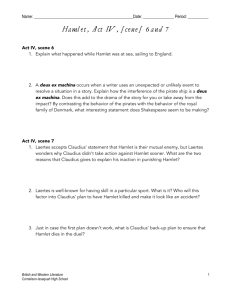2/5 - APAblog.org
advertisement
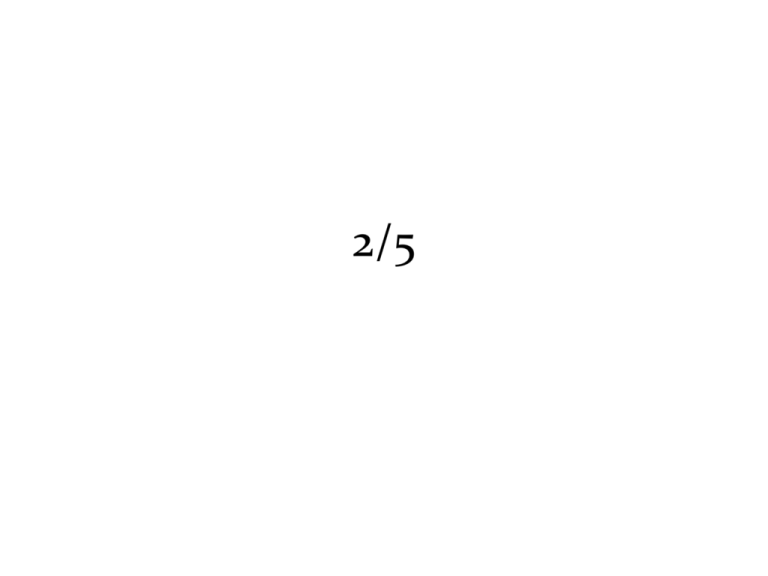
2/5 1) The King’s discussion of his marriage (lines 814) is characterized primarily by (A) irony (B) alliteration (C) contradictions (D) euphemism (E) exaggeration 1) The King’s discussion of his marriage (lines 814) is characterized primarily by (A) irony (B) alliteration (C) contradictions (D) euphemism (E) exaggeration 2. In line 23, the word “Importing” could most accurately be restated as (A) asking for (B) bringing in (C) demanding (D) concerning (E) suggesting 2. In line 23, the word “Importing” could most accurately be restated as (A) asking for (B) bringing in (C) demanding (D) concerning (E) suggesting 3. In lines 33-41, the King’s words to Cornelius and Voltemand reveal all of the following EXCEPT his (A) belief that the two men owe him allegiance (B) desire that the errand be accomplished quickly (C) belief that “old Norway” will not serve as king much longer (D) concern that the men understand the limits placed upon them (E) expression of confidence in the two messengers 3. In lines 33-41, the King’s words to Cornelius and Voltemand reveal all of the following EXCEPT his (A) belief that the two men owe him allegiance (B) desire that the errand be accomplished quickly (C) belief that “old Norway” will not serve as king much longer (D) concern that the men understand the limits placed upon them (E) expression of confidence in the two messengers 4. Line 50 contains an example of (A) litotes (B) metonym (C) irony (D) allusion (E) pun 4. Line 50 contains an example of (A) litotes (B) metonym (C) irony (D) allusion (E) pun 5. Hamlet’s words in line 67 suggest that he I. rejects Claudius’s request for Hamlet to think of him as his father II. does not look favorably upon Claudius III. rejects the notion that he and Claudius are kinsman (“cousins”) (A) I only (B) II only (C) I and II only (D) II and III only (E) I, II, and III 5. Hamlet’s words in line 67 suggest that he I. rejects Claudius’s request for Hamlet to think of him as his father II. does not look favorably upon Claudius III. rejects the notion that he and Claudius are kinsman (“cousins”) (A) I only (B) II only (C) I and II only (D) II and III only (E) I, II, and III 6. Hamlet’s words in line 69 contain an example of a(n) (A) pun (B) allusion (C) litotes (D) symbol (E) metonym 6. Hamlet’s words in line 69 contain an example of a(n) (A) pun (B) allusion (C) litotes (D) symbol (E) metonym 7. In lines 79-89, Hamlet asserts that the difference between what “seems” and what “is” is that (A) the first is imagined; the second is real (B) the first is false; the second is true (C) the first is speculative; the second is verifiable (D) the first is misleading; the second is reliable (E) the first is external; the second is internal 7. In lines 79-89, Hamlet asserts that the difference between what “seems” and what “is” is that (A) the first is imagined; the second is real (B) the first is false; the second is true (C) the first is speculative; the second is verifiable (D) the first is misleading; the second is reliable (E) the first is external; the second is internal
